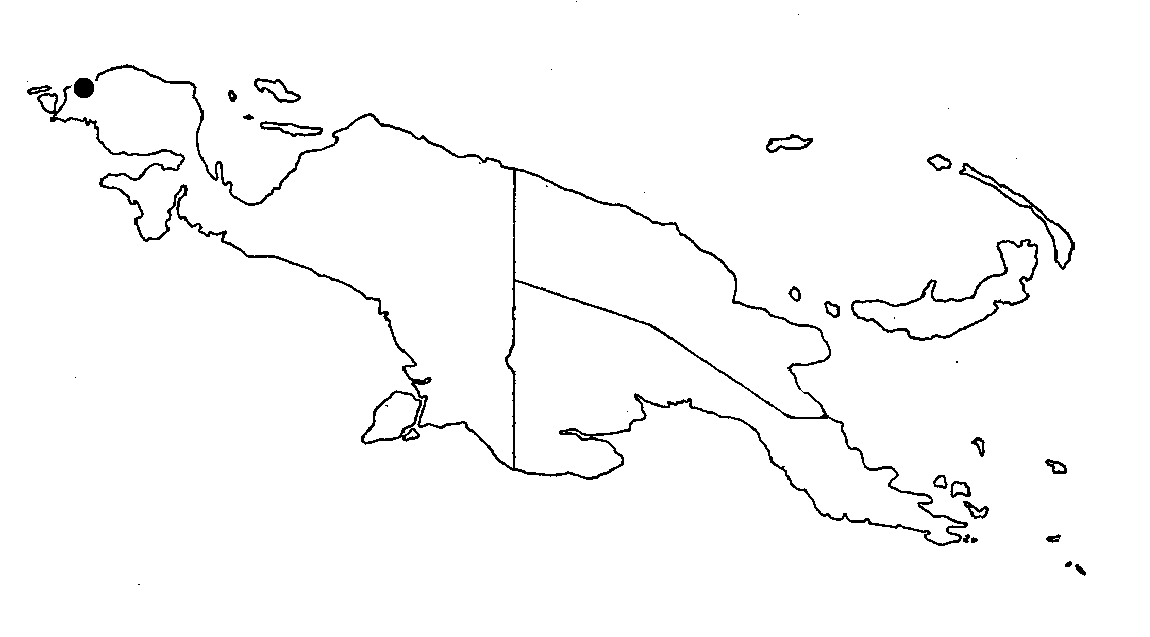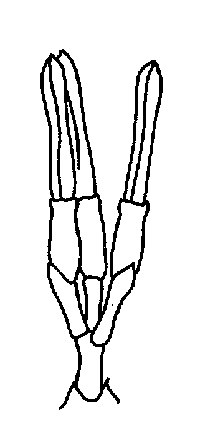
Distribution Map

Description (Barlow 1992)
Loranthus fasciculatus Blume, Bijdr. 13 (1825) 661. Amyema fasciculata
(Blume) Danser, Bull. Jard. Bot. Buitenzorg 111, 10 (1929)
295. - Type: Blume s.n. (holo L; iso L) Java, Res. Tjerebon,
G. Tjeremai, near Linggadjati.
Amyema aquilonia Danser, Philipp. J. SeL 58 (1935) 86.
- Type: Ramos BS 33296 (lecto L, see below), Philippines,
Luzon, Ilocos Norm, Mt Palimlim, 1050 m, viii.l918.
Amyema apoda Barlow, Austral. J. Bot. 22 (1974) 565. -
Type: Pleyte 708 (holo L), New Guinea, Sorong, Kemoe, 50
m, 28.viii.1948.
For full descriptions and further synonymy see Danser, Bull. Jard.
Bot. Buitenzorg III, 11 (1931) 330, under A. fasciculata, Philipp.
J. Sci. 58 (1935) 84, 86, under A. fasciculata and A.
aquilonia, and Barlow, Austral. J. Bot. 22 (1974) 565, under
A. apoda.
The essential characters for an integrated
description are as follows: Glabrous or the young inflorescence
and flowers tomentose. Stems terete, dilated at the nodes.
Leaves decussate, ternate, or quaternate, sometimes scattered;
lamina very variable, narrowly elliptic to obovate, (3-)5-10(-20)
cm long, 1-4(-12) cm wide, thinly to thickly coriaceous, dull
on both sides or somewhat lustrous above, gradually attenuate
at the base into a winged petiole obscure or up to 20 mm long,
usually obtuse at the apex; venation pennate, obscure except for
the midrib which is distinct towards the base. Inflorescences
several at the nodes and arising along the internodes, simple
2- to 4-flowered umbels; peduncle slender, 1-6 mm long; rays (0.5-)2-3
mm long; bracts spreading, acute, c. 0.5 mm long. Ovary slightly
funnel-shaped, 1.5-2.5 mm long; calyx limb erect, entire or very
weakly toothed, 0.2-0.5 mm long. Corolla in the mature
bud relatively slender, obtuse, 14-18 mm long; petals 4 (rarely
5). Anther 2-2.5 mm long; much longer than the free part
of the filament. Fruit ellipsoid, crowned by the calyx
limb.
Amyema fasciculata is distributed widely but possibly sparsely
in the Malesian region, being recorded from the Philippines (Luzon),
Borneo, Celebes, Java, Lesser Sunda Islands (Aores, Alor), Moluccas
(Sula, Morotai), and Irian Jaya (fig. 7; 19 collections seen),
at low elevations from sea level to 1500 m. Habitat details and
hosts are unknown.
Amyemafasciculata represents one of the extremes of inflorescence
reduction in the genus, and the few-flowered simple umbels frequently
arise from the epicortical runners and lenticels as well as at
the nodes. Such cauliflory is relatively common in the amyemas
of humid forests and tends to be coITelated with reduced inflorescences.
The corolla in A.fasciculata is described as red or violet
in the lower part and green above.
Amyema beccarii is occasionally confused with A.fasciculata,
in which the inflorescence can also be interpreted as a few-flowered
simple umbel. Inflorescence reduction to a simple umbel has apparently
occurred independently several times in Amyema. The derived
simple umbels may not be homologous, as they could represent,
for example, reductions to solitary cymules (i.e., triads with
all flowers pedicellate) by elimination of the peduncle and all
but one ray of the conflorescence, or reductions of each cymule
in the conflorescence to a single flower. In the case of A.
fasciculata the basic conflorescence has apparently been reduced
to a seemingly simple umbel by elimination of the rays (Danser,
1931), leaving cymules of pedicellate flowers sessile at the apex
of the common peduncle. See the note under A. beccarii. Amyemafasciculata
differs from A. beccarii in its shortly but distinctly
pedunculate umbels.
In describing A. aquilonia, Danser (1935)
commented on its close resemblance to A. fasciculata, citing
smaller leaves and inflorescence parts and lack of tomentum as
differential characters, and expressed doubts that they were specifically
distinct. Similarly, in describing A. apoda, Barlow (1974)
commented on its close resemblance to A.fasciculata and
A. aquilonia. The present study has indicated that these
three entities are all part of a single relatively polymorphic
pattern of variation, distributed over much of the Malesian region.
However, although the leaf size shows a considerable range, the
differences between all of these collections are minor, and the
species is no more polymorphic than some of the other widespread
ones in the region. Because of its common occurrence in lowland
habitats, its dispersal has presumably been facilitated by lowered
sea levels in the Quaternary.
The type specimen of Loranthus obovatus Blume (= Scurrula
obovata) bears three separate leaves which belong with Amyema
fasciculata. Danser (1931: 443) gave a detailed account of
the confusion surrounding the application of the names Loranthus
obovatus Blume and Loranthus fasciculatus Blume, which
apparently is due to aggregation of material of the two quite
distinct species on the one sheet. The three separate leaves agree
entirely with the holotype material of L. fasciculatus, and
are probably part of the same gathering.
The holotype of Amyema aquilonia (PNH) is no longer extant.
An isotype in L has been seen and designated lectotype of the
name.
Description (Barlow 1974) as Amyema apodum Barlow, sp. nov.
Type-West Irian, Sorong, Kemoe, 50 m alt., Pleyte 708, 28.viii.1948 (L 952131106, holotype).
Glaber. Caules teres. Folia displicatae-ternatae; lamina elliptica, c. 8 cm longa, c. 4 cm lata, apice obtusa, margine recurvata, supra polita, subtus impolita brunneola, basi in petiolum 6-10 mm longum attenuata; nervatione penninervis, costa utroque nervis lateralibus distinctis. Inflorescentiae in axillis plures ortae, pedunculatae, umbellatae; umbellae 3-radiatae; pedunculus (fortasse immaturus) 1-2 mm longus; radii (fortasse immaturi) 2-3 mm longi; bracteae patulae, acutae. Calyx leviter infundibuliformis, 2 mm longus; limbus erectus, leniter dentatus. Corolla in alabastro gracilis, leviter clavata, 5-merus, ignota ubi matura.
Glabrous. Stems terete. Leaves scattered ternate; petiole 6-10
mm long; lamina elliptical, c. 8 by 4 cm, lustrous
above, dull brownish below, attenuate at the base, recurved at
the margin, obtuse at the apex; venation pennate with only the
main veins distinct. Inflorescences several in the axils, each
consisting of a simple 3-rayed umbel (perhaps a sessile 4- to
6-rayed umbel of triads with all flowers pedicellate); peduncle
of the umbel (perhaps immature) 1-2 mm long; rays (perhaps immature)
2-3 mm long; bracts spreading, acute. Calyx slightly funnel-shaped,
constricted at the base of the limb, 2 mm long; limb erect, weakly
toothed. Corolla in the immature bud slender, slightly clavate,
5-merous. (Fig. 5, c.)
Occurrence. Sorong district, West Irian (Fig. 4), 50 in altitude.
Specimens Examined. WEST IRIAN: Sorong, Kemoe, 50 m alt., Pleyte 708, 28.viii.1948 (L).
Amyema apodum is
distinguished from all other New Guinean species of the genus
by its inflorescence structure, which is probably a reduction
from the umbel of triads borne by most species. The most closely
similar inflorescence type in New Guinea is that of A. seemenianum
and A. squarrosum (cf. Barlow 1964), but there are
no other indications of close relationship. Amyema apodum may
be more closely related to the Philippine species A. fasciculatuin
and A. aquilonum, which have quaternate leaves and
4-rayed simple umbels.
Illustrations

Amyema apodum. immature inflorescence. From Barlow (1974).
Photographs
Amyema fasciculata
updated 18 January 2007